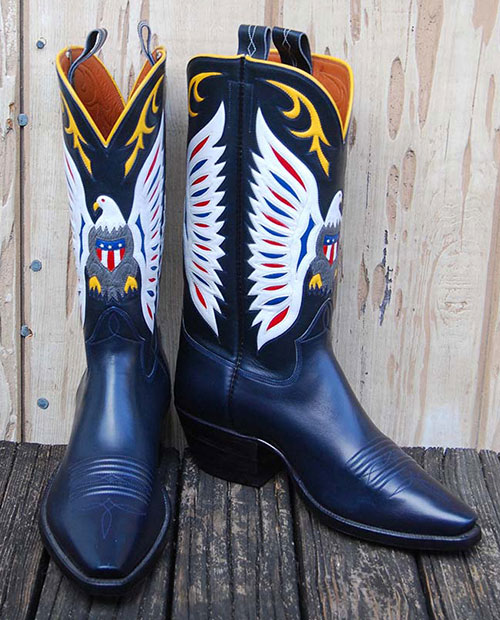
by Lynn Ascrizzi
Virtually every day of the week, and even on Saturdays, you’ll find bootmaker Lee Miller leaning over a busy workbench in his Austin shop, Texas Traditions. He might be shaping toe boxes with a file, setting up lasts, sewing heel seats, drawing patterns or working at one of the hundreds of other operations that go into building custom cowboy boots.
Or, he might be coaching an apprentice on how to complete yet another intricate step in the craft, just the way he was once trained by legendary, fifth-generation boot master Charlie Dunn (1898 – 1993).
In 1977, when Miller first walked into Dunn’s workshop, what followed was a formative and turbulent, nine-year apprenticeship with the feisty, Texas bootmaker. Dunn was 79, at the time. Today, 41 years later, Miller is faithfully carrying forward his mentor’s legacy, and in that same location. Yet, he’s not one to put on airs, nor does he enjoy being called, as he has by some, “the greatest living bootmaker.”
“Well, I don’t pay attention to that. I consider myself a journeyman. I don’t call myself a master,” he said. “This is a journey I am on. I don’t think you ever master it. It’s just a title. It means you’ve been doing it a long time. Anybody who knows how to make shoes or boots knows there are different levels of ability. I don’t consider myself the greatest bootmaker in the world. I love what I do and always try to do better work.”
Warming to this theme, he drew an analogy between building boots and making a guitar. “There are great guitar makers, but no ‘best,’ ” he insisted.
To talk with Miller, 63, is like conversing with someone you’ve met before, but can’t quite remember where; he is that down-home and at ease with folks. But despite his modest opinions about his talent, it is plain to see that his shop’s world-class leatherwork has added a heap of star quality and expertise to the rich tradition of Texas bootmaking.
Yet, he readily admits that the life work he chose has not been easy. “I never knew what I was getting into. Bootmaking is so bloody hard. It isn’t that you just have to make them — you have to make them right, design them right, put them together right. I’m working on a pair right now. It might take two weeks to make them.”
In the next breath, that complaint turned into a lover’s quarrel. “In life you have to have a passion. This is my art — my craft. When I wake up in the morning, it’s something I want to do. . . . It’s a lot of fun and every day is a bit different. It’s hard, and you have to be there — go to work, and work late, or seven days a week, sometimes. You do what you gotta do.”
A Texas Traditions boot, he said, is recognized for four distinctive qualities: First, is the fit. Second is the silhouette, or line, which he described as “sleek and timeless. I’m really known for the toe shape. I create the last and build the toe. When you look at a boot, the first thing you see is the toe.” Third is the boot’s construction. And fourth, its design.
“People who know boots, know who has made them,” he said. He recalled a recent gathering where a young woman informed him that the pair of cowboy boots she was wearing had belonged to her mother. “She told me, ‘Oh, these are Charlie Dunn boots.’ And I said, ‘I know. I made them.’ ”
Miller’s boot workshop is located in a 700-square-foot building about one mile south of the Colorado River, close to downtown Austin. It is open to visitors during work hours. In 1984, the building’s owners totally rebuilt the old shop, now designed with an office and workshop separated by a breezeway.
“In the original workshop that Charlie worked in, the roof leaked every time it rained,” Miller recalled.
BOOT WEARERS AND BOOT PRICES
Texas Traditions customers come from diverse backgrounds, but share one, big thing in common — an undying desire to own a pair of authentic, traditionally-made cowboy boots. And, not only fancy, dress boots. “We’re doing anything. If somebody wants it, we’ll make a working cowboy boot, too,” Miller said.
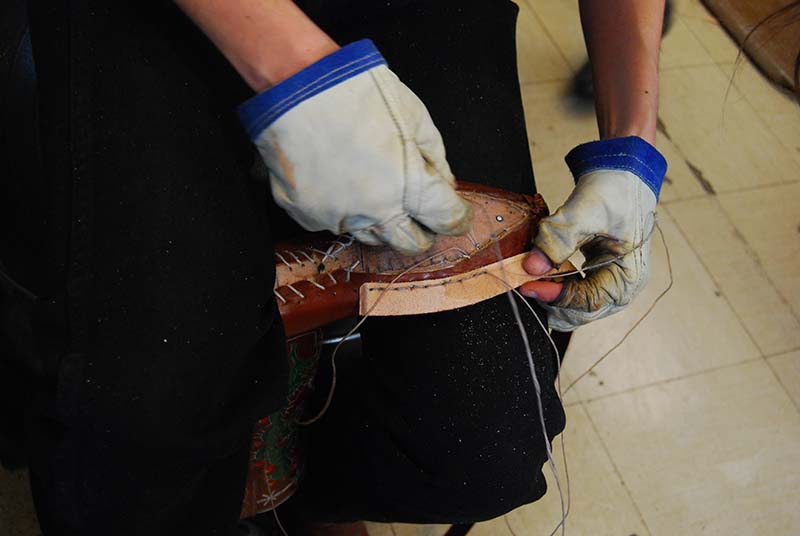
He does the measuring. “Whoever measures the foot should be the one who sets up the last. It’s for accuracy. Many places do not do it that way. The more people that get involved with a foot, the more things can go wonky. People make mistakes,” he said.
Customers have included a number of well-heeled musicians, including the likes of Lyle Lovett, Sting, Jackson Browne, David Crosby, Gillian Welch, Guy Clark and Willie Nelson. “I love musicians. It’s what I wanted to do as a young person,” Miller said. The celebs list also includes Tommy Lee Jones, who wore Texas Traditions boots in the 1989 movie, Lonesome Dove, TV star Harry Connick Jr., and the late actress, Lauren Bacall.
Roughly, 70 percent of their boot orders come from the professional class, such as lawyers, businessmen and doctors. “In Texas, doctors wear cowboy boots, even in the operating room,” he said.
“We also have people paying $100 per month, until their boots are paid up, like the woman who worked in a factory making stadium chairs, and a bus driver. That’s a very common occurrence. Some bootmakers tell you they make boots for only the 1 percent. We don’t. We make boots for anybody who wants a pair of boots.”
Sixty-five percent of their customers are men. And, 80 percent of sales are made in the United States; other orders come from countries all over the world, including France, Germany, Australia, Switzerland, Japan and Dubai. “So far, no boot orders from China or Egypt,” he said, noting that Japan is especially smitten by cowboy culture. “We had one customer from Japan who only put on his cowboy boots when he watched a TV Western.”
Boot prices vary. For boots built of non-exotic calfskin, cowhide, kangaroo, water buffalo, pigskin and bull hide, the base price is $2,900. Boots made of exotic leathers, like ostrich, alligator, crocodile or lizard, can go up to $12,000. Overall, prices are largely determined by the amount of boot details, such as custom inlays and the like. “There’s no limit. It’s all labor,” Miller said.
To put those prices in perspective, he offered another musical analogy. “Honestly, a guitar player will spend $3,400 on a Gibson,” he said, of the iconic, hand-built, U.S.-made guitar. “Lots of musicians have Gibson guitars. Cowboy boots are relative to Gibsons.”

Design-wise, Texas Traditions boots can range from fancy, with lots of decorative stitching, colorful inlays and overlays, to a far simpler or even plain style, depending upon what customers want. That day, Miller was finishing a very fancy pair, with a silver barbed-wire design wrapped around the boot top, a prickly pear cactus and inlaid snake design on the upper front, and an inlaid initial on the back. That pair represented two weeks of work, he said.
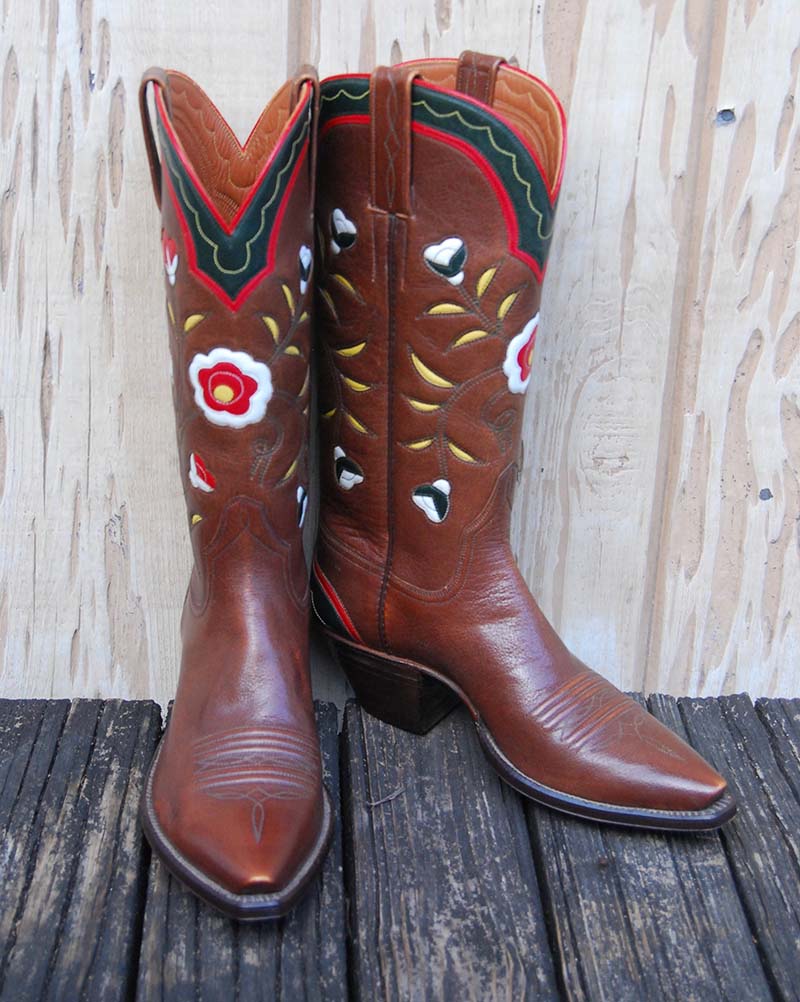
Other motifs include decorative forms like roses, half-moons and stars. “A guy into astronomy wanted different star formations on his boots. People put a lot of thought into it,” he said.
BOOT LEATHERS
All their leather is sourced from U.S. suppliers. “Most people who make cowboy boots use the same suppliers. There are only so many leather suppliers in the U.S.,” Miller pointed out. People mix and match what leathers they want. They might choose calfskin or water buffalo for boot tops, and kangaroo, ostrich and alligator for the feet,” he said.
The Austin workshop sources ostrich leather from Kelly-Larson Sales, an exotic leather supplier with offices in Bedford, Texas, and a warehouse in El Paso. Kelly-Larson is the sole representative for Klein Karoo International, the largest and oldest ostrich tannery in the world, located in Oudtshoorn, in the Western Cape province of South Africa.
“Klein Karoo, a co-op, introduced ostrich leather in the 1950s. In my opinion, they make the best ostrich. They’re the number-one supplier in the world and use all ranch-raised ostriches,” he said.
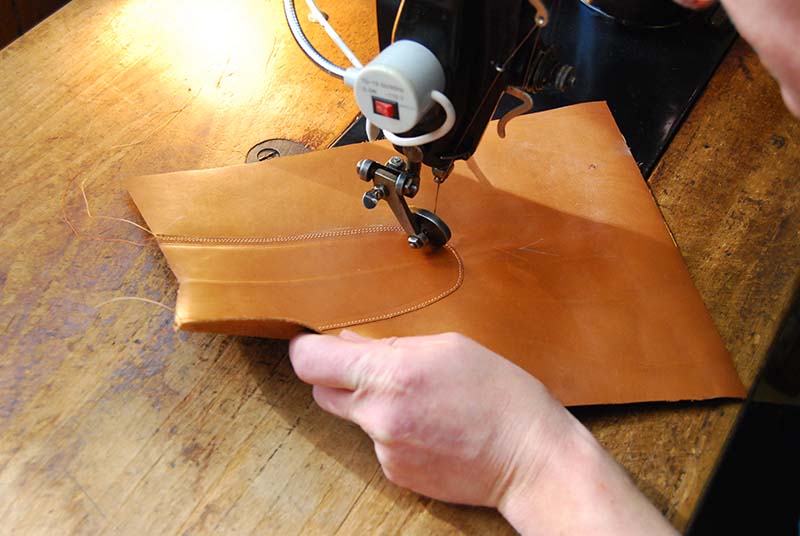
They also work with calfskin tanned in France, purchased from GH Leather of Houston, Texas, a supplier of high-end leather imports. Lining leather is from Thiele Tanning of Milwaukee, Wisconsin. Sole leather is ordered from Keystone Leather of Williamsport, Pennsylvania. “They sell leather tanned in Belgium and Mexico. Most of the leather we get is not tanned in the U.S. Our leather outsoles come from Belgium,” he said.
BATTLING THE BACKLOG
How many pairs of finished boots walk out of the shop, annually? “We try to make 100 pairs of boots per year,” Miller answered. “It’s our goal, and we very rarely achieve that. We’re not a factory that deals in volumes — in thousands of boots. We just try to make as many as we can.”
“We’ve got a four-year backlog,” he added. “When we first bought the shop, the backlog was five months long. Overtime, it grew. Most people aren’t willing to wait four years. . . . There are plenty of bootmakers who don’t have a four-year backlog,” he said.
That pileup, he admitted, puts his workshop under constant pressure to catch up on orders. “It never ends. Right now, we’re only working on existing orders. If you wanted another pair, yes, we’d take your order. The old customers are the bread and butter of your workshop. They repeat orders,” he said.
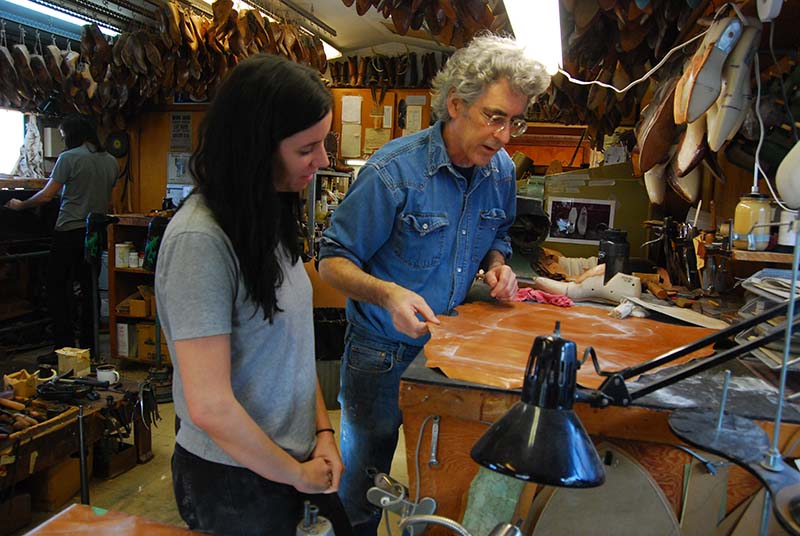
They keep two lists — their existing, repeat customers and new customers ordering their first pair. Existing customers have an 18-month waiting time. “Apprentices speed things up, but at the same time, we have to train them,” he said.
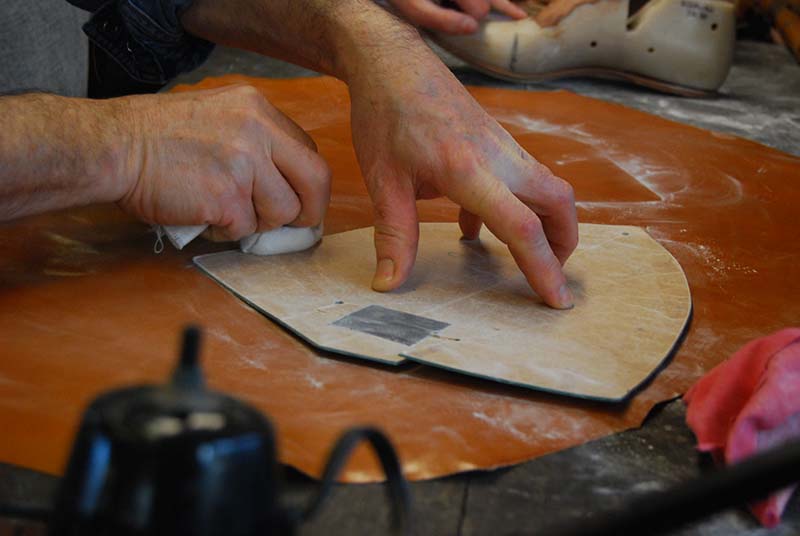
About one to two boot orders roll into the shop, every week. “Because we’re so small, it doesn’t take much to get backlogged. Generally, what we do is, work the backlog down and open up the orders. Then, we’ll get backed up again, so we stop taking new customers.” Miller estimated that they’ll start taking new customers in about two years.
Meanwhile, folks who have succeeded in getting an order in should hold on tight to their ticket and call themselves lucky.
TOOLS OF THE TRADE
Miller talked about some of the leatherworking tools that cram his workshop — items that get used countless times per week.

• Fitter’s hammers and needles for machine sewing –“I’m always using a fitter’s hammer, a tiny tool that fits in the palm of your hand. Ours are from Pilgrim Shoe & Sewing Machine Co., in Woburn, Massachusetts. They’ve been around for 50 years. When I need needles for machine sewing, I call them up,” he said.
• Needles for hand sewing –“The ones we use are made out of fishing line. We used to use hog bristle to attach the thread. It’s hard to find, and expensive. Some people hand sew with needles, but not us. We rarely use a saddler’s or harness needle.”
• Sewing machines – “Our primary machine is a Singer 31-51, made since the 1900s. Every shop knows what this machine is. It’s like a workhorse. You can also get a Juki or PFAFF for leather sewing. They’re all good machines. I’ve got a bunch of them. They’re easy to work on, simple to use and not computerized.”
• Post-bed sewing machine – “They’re mostly used by shoemakers. We use a Juki. Its post rises up out of the table. Basically, we’re sewing in the air. For any leather item that has a shape and is not flat, we use a post machine.”
• Stitchers – “I have two — a Landis curved needle stitcher and an American Straight Needle; both are used for heavy stitching.” The American Straight Needle, a machine made for saddle, harness and bootmakers, “is a long-gone company. I have one made in 1910. It’s still working.”
• Sanding machines – “We use an old Landis 150, a belt-driven, 12-foot-long line finisher, made around WWII. And, we have a modern Sutton Finisher, made in 1980, also belt-driven, with an internal dust collection system. The machinery for sanders hasn’t changed much. There are no computers in either one. If you went into a 1900’s boot shop, the machines would be basically the same.”
• Lasts – “All our lasts are made by Jones & Vining of Walnut Ridge, Arkansas, the only last manufacturer in the U.S. that’s left. They have a bootmaker’s model. A last represents a bootmaker’s fitting philosophy,” he said, of the form that is the foundation of a shoe or boot. Or, as Charlie Dunn reportedly put it: “In bootmaking, the last comes first.”
“I created my own model. I started with a plastic last. Jones & Vining send you different models, and you go ahead and shape it. You send that back and they copy it. Then, they send it back to you for trial fitting and to make sure the measurement is correct. Once you have a standard model, that’s what you make.”
• Leather treatments – For conditioners, the boot shop uses Cadillac Boot and Shoe Care Leather Lotion of Whitmore Lake, Michigan, and Kali Leather Life, manufactured by Kalico Products in Milton, Louisiana. “We use it (Kali) mainly for reptile leathers, like lizard,” Lee’s wife, Carrlyn Miller said. They also like Saphir Medaille D’or line of conditioners, polishers and cleaners from France. “We use their whole line. Their polish won a gold medal in 1925 and they haven’t changed the formula. Expensive. We love it,” Lee Miller said.
PASSING THE TORCH
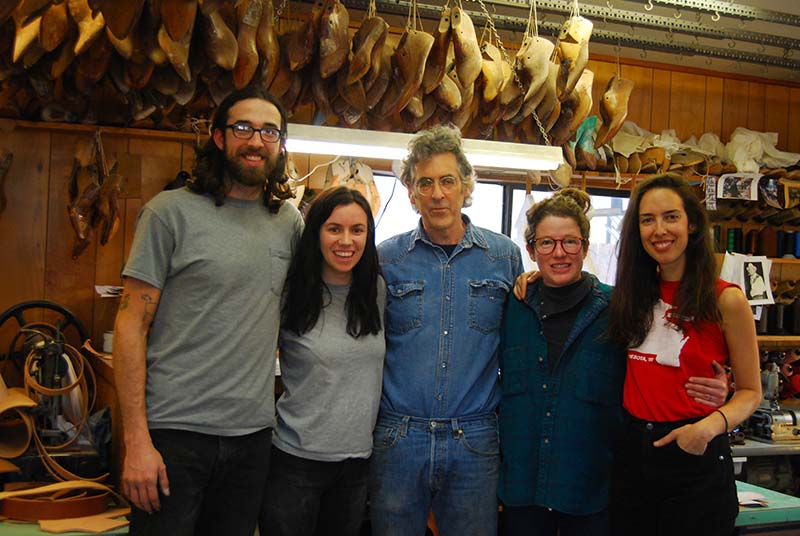
Currently, four apprentices are working at Texas Traditions — Charlotte Marshall, 28; Dana Perrotti, 31; Jojo McKibben, 35; and recent, part-time arrival, Graham Ebner, 26; from the Houston area.
Miller is involved in every step of the bootmaking process and works closely with the apprentices. “Currently, I do boot designing, draw paper patterns, measure people’s feet, make the lasts. Then, apprentice Charlotte starts cutting and sewing. She’s mainly doing tops,” he said. Once the upper is complete, it goes back to him. “All the fancy work is done. I do the lasting — stretching the upper over the last.”
Except for his part-time newcomer, apprentices get paid by the hour, just as Miller had been when he worked for Dunn. “When I was paid a wage by Charlie, I was surrounded by people more skilled than me. When an apprentice can make a difference, you have to pay them. As a bootmaker, I need help. You have to train them. You just don’t find them,” he said.
Every apprentice starts part-time. As skills increase, they go full time. “The idea for everyone is to learn the whole process,” he added. “It’s slow. We break it up into segments. This is the way it was done for me, when I worked for Charlie. He let me go ahead and learn everything. That’s the idea here. You’re not just pigeonholed.”
In his opinion, the art of handmade cowboy boots is not, as some claim, fading into the sunset. “The older bootmakers have gone. But as long as young people pick it up, it won’t be a dying art form. There’s a lot of interest and a resurgence in crafts, in general. You have to find someone who wants to make boots. The future for me is making boots, teaching more and writing a book.”
In fact, Miller has begun outlining a how-to book that will include boot history and anecdotes. “As a joke, I’m giving it the working title of, ‘Zen and the Art of Boot Making,’ ” he said, a tongue-in-cheek reference to the 1970’s counter-culture classic, Zen and the Art of Motorcycle Maintenance.
“I’d like to have it ready in a year,” he said.
THEN AND NOW
Lee Miller, who grew up in Rutland, Vermont, was drawn to the world of footwear early on. “When I was a kid, I spent a lot of time in the shoe department in my grandfather’s clothing store,” he said.
But the last thing he wanted was to work in retail. “I wanted to be an archaeologist — to study the past. I also wanted to be an artist. Cowboy boots are like sculpture. You use artistic methods that are historical. I see those two things coming together in my life,” he reflected.
In 1972, he graduated from Rutland High School, filled with a burning desire to get into handmade crafts. “People were doing that then — trying to get back to the old times,” he said. His searching led him to Oklahoma State Tech in Okmulgee, Oklahoma, (now Oklahoma State University Institute of Technology). At the time, they offered a bootmaking program.
One of his fellow students was Wichita-born, Steven Craig Martin. Their friendship would last a lifetime. The winding trail, which eventually led both of them to the workshop run by famed bootmaker Charlie Dunn, was an amazingly serendipitous one.
Miller graduated in 1976 and got a job at Merrell, a one-man, bootmaking shop founded by Randal I. Merrell in Vernal, Utah. Today, the business by that name is an American footwear giant that specializes in high-performance hiking boots. A year later, Miller left Merrell to run a small leather goods and repair shop in Roosevelt, Utah. While there, he lived on a Ute Native American reservation at Fort Duchesne.
Martin graduated a year later and moved to Austin to apprentice with Dunn, who at age 79, had opened a workshop in hopes of passing on his bootmaking skills to a new generation. Martin was anxious to tell Miller about the exciting opportunity — that Dunn was looking for help. But, he had lost track of Miller’s whereabouts. Martin searched for four months, until he finally caught up with his friend.
Upon hearing the news, Miller jumped on a plane in Salt Lake City and flew to Austin. He was elated by the prospect of working with the very Texas bootmaker who had skyrocketed to national prominence with the release of Jerry Jeff Walker’s folksy country song, “Charlie Dunn.”
The reality of Dunn’s workshop, however, stunned Miller to the core. “I had never seen anything like the level of workmanship Charlie and his crew were doing. I had seen a lot of bootmakers, but I thought, ‘This is impossible! How in hell am I going to learn this?’ I cried, privately. But I hung in there. I kept trying and asking questions, begging for help. The crew was predominantly Mexican. In terms of skill level, the Mexicans were far superior. They’d been doing it their whole lives.”
Miller was only in his early 20s, when he first apprenticed with the intensely gifted, hot-headed, impish bootmaker. “He was a short Irishman and probably weighed 135 pounds,” he recalled. “In fact, he fired me many times; once, when I didn’t laugh at his jokes. I got used to it. I’d leave the shop and go home. By the time I got home, the phone was ringing. It was Charlie. He fired everybody. He was quick to anger, quick to say he was sorry.”
He often got ribbed about his Vermont upbringing. “Charlie used to say: ‘You’re a damn Yankee, but we won’t hold that against you.’ ”
For three years, Miller and Martin worked in the old Texas Traditions shop. Then, Martin left to open his own business. For more than 20 years, he ran Rowell’s Shoe and Boot Repair in Austin. He passed away on Jan. 4, 2018, at age 68, in Georgetown, Texas.
“I had just seen him during Christmas,” Miller recalled. “He died suddenly. He was a fixture in my life. I had known him for 42 years. If it weren’t for him, I wouldn’t have met my wife, Carrlyn. And, I wouldn’t have wound up working for Charlie Dunn.”
He and Carrlyn first met in 1980, when she answered Dunn’s ad for a secretary. “It was love at first sight, on my part.” he said. They married in 1985 and have been a working team ever since.
In 1986, Dunn left the workshop to retire for the second time. He was 88. By then, he had passed on to Miller his treasured secrets. That same year, the Millers bought the business. “He wanted out; I wanted in. I was ready. I was 32,” Miller said. “Texas Traditions is like no other place in the U.S., set up to continue the craft. Now, I have young people here.”
“It was an easy transition because I had already worked there,” Carrlyn Miller said, of the day they first stepped into their own bootmaking business. “All the customers knew us. Charlie would be out for quite a while. Lee knew his role, I knew mine. It’s really something — the fact that we do work together.”
“Without her, the shop wouldn’t exist,” he said, of his wife of 33 years. They live in a 1930’s brick house, next to the boot shop. Their grown son, James, teaches history in an Oklahoma high school.
Until a couple of years ago, she did the shop’s primary finishing work. Currently, she handles scheduling, answers phones, pays bills and works with customers who come into the shop. With her, they discuss designs and the kinds of leather they want for their boots. “I show them the leather room, which has all the different leathers we work with. People ordering boots generally come by appointment or referral,” she said.
For the Millers, shop work is an entrenched way of life. Do they take vacations? “No vacations,” she said, adding that they sometimes take long weekends. “We’re closed the week between Christmas and New Year’s. We spend part of that time working in the shop, behind closed doors,” she said.
As for Charlie Dunn, he spent his last years living in a small community outside of Smithville, about one hour east of Austin. He died at age 95. He was buried wearing a pair of black kangaroo boots with six rows of multicolored stitching. Miller had made them for him, two years earlier. “He told me he liked them so much, he slept in them,” he said.
AFTER CHARLIE, SOME CHANGES
To the venerable Texas bootmaker, Charlie Dunn, there was one right way to make a boot — his way. Yet, as Lee Miller of Texas Traditions recalled, he was also open to new suggestions, as long as he thought they were a good idea. As it turns out, many of his traditional, tried-and-true techniques are still a big part of Miller’s process. But, over the years, he has revised some of the methods that Dunn drummed into him.
“For the most part, in its totality, bootmaking is still the same process it always was. But, you’re always asking, ‘maybe I should try this.’ You make these little tweaks. You find a different way to assemble or finish something and add these processes to the whole mix,” he said.
What follows are some of Miller’s methods that differ from Dunn’s – and a couple that remain.
• Fitting – “The biggest thing I learned from Charlie is how to fit boots. Fitting feet has been my main focus for a long, long time. I’m always thinking about it, trying to better myself. But, if you were to dissect it, I don’t set up a last the way Charlie did. I take more measurements. I trace the foot the way he did, but I also do an ink print and a side profile. Charlie never did that. I take more data for the foot and that helps to create less problems down the road.”
He fondly recalled what Dunn used to say about fitting certain customers: “We can fit their feet, but we can’t fit their head.”
• Heel seats – “Charlie was nailing the heel seats with iron nails. I’d ask him: ‘Aren’t you concerned that the heel seat will rust out?’ He said: ‘By the time the heel seat rusts out, the whole insole will be rotted out. So then, you replace the whole insole.’ ”
Later, Miller abandoned the nail method. To explain why, he launched into a historical anecdote about footwear worn by the U.S. Cavalry in the 19th century. “Their boots were cheaply made. What happened was, the insole that your foot rests on loses moisture and gets thinner. The nails used in the heel seat, over time, became ‘proud.’ They stuck up. I noticed that was happening to the boots that Charlie and I made. So, I tried wooden pegging. Now, I hand sew the heel seat and eliminate the nails.”
• Hand threads – “Charlie Dunn had all these rules,” Miller recalled. “When making a leather toe box, he said you had to make your own hand thread. For a man’s boot, that’s nine strands of flax, woven together. It’s what you sew a boot with, when you’re ‘bottoming’ the boot,” he explained.
After Charlie retired, Miller stopped making hand threads. Today, he uses synthetic threads purchased from Rusty Vallee, owner and operator of Maine Threads in Lewiston, Maine. “They’re not going to rot and they’re inexpensive. We used to get the Charlie Dunn boots back to repair, with the threads all rotten. Most people in the U.S. who make boots today, use Vallee’s threads.” He pointed out that other thread manufacturers require “huge minimum orders.” Maine Thread sells threads in bulk to big factories and in smaller 70-yard spools.
• Sideliners – Miller recounted the time a London shoemaker visited the Austin shop. “He said: ‘You don’t have any sideliners in your boots!’ That’s an extra piece that goes from the heel stiffener, all the way along the side of the boot, to the toe stiffener. You can’t see it. It’s used in shoemaking. Cowboy bootmakers, generally, don’t put those in.
“At the time, I was using a sideliner only for boots made with exotic leathers, but not with normal leathers, like cowhide. It’s hidden and prevents cracking. I do sideliners now with every boot. Any cowboy boot you buy off a shelf doesn’t have a sideliner in it. Factory footwear is all about cutting down on labor. A lot of folks, when it comes to footwear, buy cheap,” he said.
• Leather toe boxes – To shape a toe box, a stiff piece of material is inserted at the front tip of the boot, between the boot lining and the outside leather to add more durability. In this instance, Miller’s method remains basically unchanged from Dunn’s bootmaking dictum.
“When I first went to work for Charlie, he told me: ‘You have to use a leather toe box!’ Everybody else was doing fabric. Ninety percent of boot and shoemakers today, use fabric or plastic. They’re trying to eliminate labor, make more boots and make more money. We do it old school. The leather toe box is the original way of doing a toe box,” he said.
A leather toe box involves more labor, drying time and shaping, he explained. “A lot of bootmakers say this is too hard. The fabric toe was introduced in the 1950s.
After it’s draped and is dry, it requires minimal shaping. Nowadays, they also use plastic. You simply buy the toe box and shape it. Thermal fabric is also used. The fabric is impregnated with a stiffener and heat activated.”
Miller stands behind his belief in the virtues of the leather toe box. “It’s traditional, it’s not going to break down and it’s leather. The problem with all new technology is one day something is available and the next day, you can’t get it. Leather is forever. If you go to a bootmaker’s convention today, only a few use a leather toe box. In Europe, makers of handmade shoes are using leather toe boxes.”
• The 40-penny nail – Miller uses a 40-penny nail to reinforce the boot arch — the steel shank. Old-timers, like Dunn, beat the nail flat and shaped it to fit a customer’s foot. Dunn also used a 60-penny nail on very large boots. The technique is as old as the hills.
“I have a book on ancient footwear,” Miller said. “The Romans were using that nail in their footwear! Charlie used to call the 40-penny nail a ‘bridge timber spike.’ In Charlie’s day, that’s what they were using to put bridges together.”
QUOTES
“In life you have to have a passion. This is my art — my craft. When I wake up in the morning, it’s something I want to do.” — Lee Miller, Texas Traditions
“Whoever measures the foot should be the one who sets up the last. It’s for accuracy. The more people that get involved with a foot, the more things can go wonky. People make mistakes. Many places do not do it that way.” — Lee Miller, Texas Traditions
“The old customers are the bread and butter of your workshop. They repeat orders.” — Lee Miller
“Some bootmakers tell you they make boots for only the 1 percent. We don’t. We make boots for anybody who wants a pair of boots.” — Lee Miller
“The older bootmakers have gone. But as long as young people pick it up, it won’t be a dying art form. There’s a lot of interest and a resurgence in crafts, in general.” — Lee Miller
FOLLOW THE BOOT-MAKING PROCESS
Lee Miller posts Texas Traditions shop photos regularly on his Instagram account @texas_traditions_boots. The private site displays hundreds of examples of work in progress and other shop photos. To gain access to his site, click on “Follow” and Miller will give access. “People follow our Instagram site all over the world. We show the process,” he said.
CONTACTS
Texas Traditions
2222 College Ave.
Austin, TX
1-512-443-4447/8
texastraditions@mac.com
Explore the sections on English and Western Tack, Racing Tack and Equestrian Apparel right here on EIE.
































